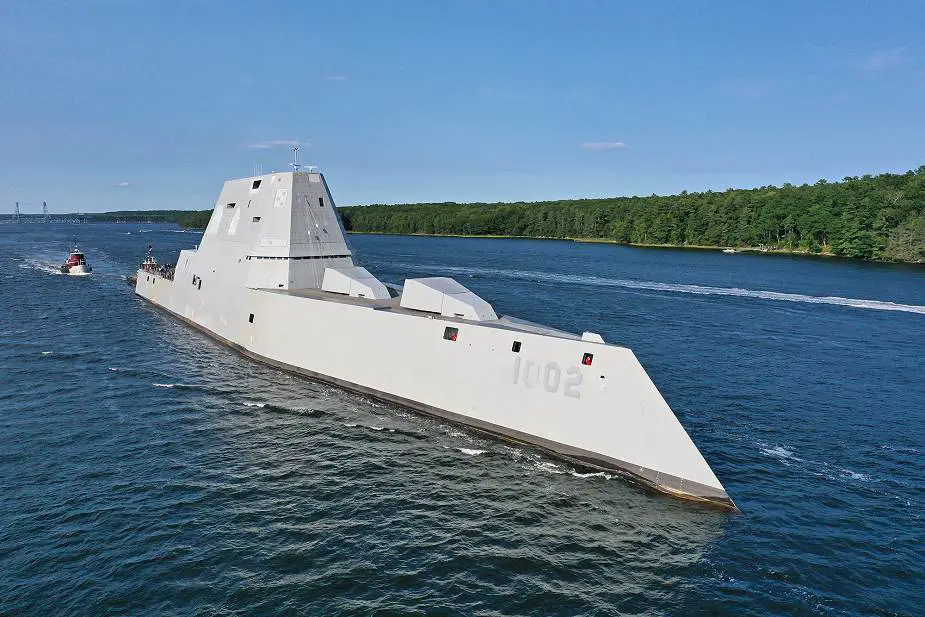According to information released on September 2, 2021, the future USS Lyndon B. Johnson (DDG 1002) Zumwalt-class destroyer for United States Navy returned to General Dynamics Bath Iron Works Wednesday, September 1, 2021, following Builder’s Trials. Lyndon B. Johnson is the third in the Zumwalt class of destroyers.
Follow Navy Recognition on Google News at this link
 Future USS Lyndon B Johnson DDG 1002 Zumwalt-class destroyer for U.S. Navy heading out to trials. (Picture source General Dynamics Bath Iron Works)
Future USS Lyndon B Johnson DDG 1002 Zumwalt-class destroyer for U.S. Navy heading out to trials. (Picture source General Dynamics Bath Iron Works)
“During the five-day trial, the BIW-Industry-Navy team successfully demonstrated the operational capabilities of all hull, mechanical and electrical systems,” said Edward Kenyon, BIW Program Manager. “Throughout the trial, the ship and trials team performed well.”
“This is an important day for Bath Iron Works,” said President Dirk Lesko. “The success of this trial moves us closer to delivering this ship and returning our focus to increasing the pace of DDG 51 construction. Achieving this milestone is the result of tireless effort on the part of the BIW-Industry-Navy team who have our gratitude for a job well done.”
In addition to Lyndon B. Johnson, Bath Iron Works currently has under construction Arleigh Burke-class destroyers Carl M. Levin (DDG 120), John Basilone (DDG 122), Harvey C. Barnum Jr. (DDG 124), Patrick Gallagher (DDG 127), Louis H. Wilson Jr. (SSG 126) and William Charette (DDG 130).
USS Lyndon B. Johnson (DDG-1002) is the third and final Zumwalt-class destroyer built for the United States Navy. The contract to build her was awarded to Bath Iron Works located in Bath, Maine, on 15 September 2011. The ship was launched December 9, 2018, and christened April 27, 2019.
The Zumwalt is a class of guided missile destroyers designed to provide multi-mission offensive and defensive capabilities, including Anti-Air Warfare (AAW), Anti-Submarine Warfare (ASW), and Anti-Surface Warfare (ASuW). The Zumwalt class can operate independently or as part of Carrier Strike Groups, Surface Action Groups, and Expeditionary Strike Groups.
The DDG 1000 or Zumwalt-class is the first U.S. Navy surface combatant to employ an innovative and highly survivable Integrated Power System (IPS). Key design features that make the DDG 1000 IPS architecture unique include the ability to provide power to propulsion, ship's service, and combat system loads from the same gas turbine prime movers. DDG 1000's power allocation flexibility allows for potentially significant energy savings and is well-suited to enable future high energy weapons and sensors. The ship uses active and passive sensors and a Multi-Function Radar (MFR) capable of conducting area air surveillance, including over-land search and track, throughout the extremely difficult and cluttered sea-land interface.
The Zumwalt-class features all-electric propulsion including two Rolls-Royce MT30 gas turbines each developing 35.4 MW (47,500 hp) driving Curtiss-Wright electric generators, two Rolls-Royce RR4500 turbine generators each developing 3.8 MW (5,100 hp) and two propellers driven by electric motors. The ship can reach a top speed of 30 knots (56 km/h). She has a complement of 147 people.
The Zumwalt-class has a length of 190 m, a beam of 24.6 m, a draft of 27.6 m, and a displacement of 15,907 tons. She has a flight deck and an enclosed hangar for up to two medium-lift helicopters. The ship is able to carry SH-60 LAMPS or MH-60R naval helicopter and three MQ-8 Fire Scout VT-UAVs (Unmanned Aerial Vehicles). The ship is armed with 20 MK 57 VLS modules, 4 cells per module, 80 launch cells total that can launch RIM-162 Evolved Sea Sparrow Missiles (ESSM), Tomahawk cruise missile, or Vertical Launch Anti-Submarine Missile (ASROC). Other armaments also includes two155 mm (6 in)/62 caliber Advanced Gun System and two 30 mm (1.2 in) Mk 46 Mod 2 Gun Weapon Systems.



